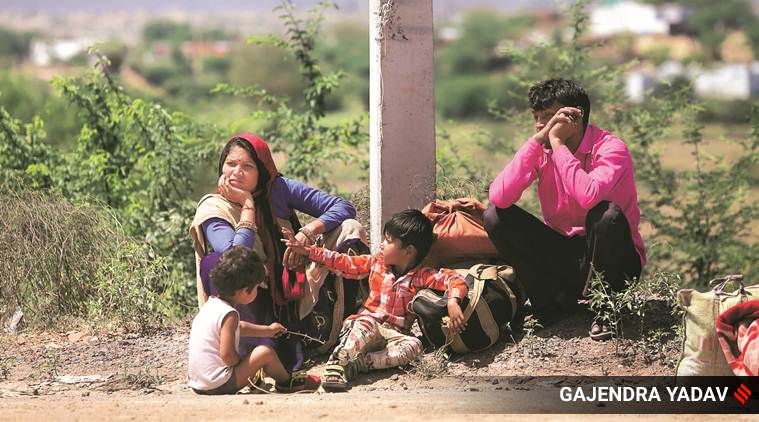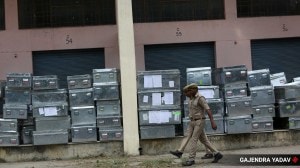- India
- International
‘It’s now a question of survival’: Migrant workers from Seemanchal
As the government extended the lockdown by 19 more days, migrant workers from Seemanchal -- consisting of Kishanganj, Purnea and Kathihar in Bihar and Uttar Dinajpur in West Bengal -- are staring at a bleak future.
 Every year thousands of unskilled workers leave for urban centres in search of work, as agriculture, the mainstay of the region’s economy, does not generate enough employment. (Express photo by Gajendra Yadav)
Every year thousands of unskilled workers leave for urban centres in search of work, as agriculture, the mainstay of the region’s economy, does not generate enough employment. (Express photo by Gajendra Yadav)
Thirty-eight-year-old Asghar had left for Jodhpur from Pichhla village in Bihar’s Kishanganj district – one of the poorest regions in the country — seven months ago. Youths from the area who were already working in the Rajasthan city helped him find employment at an embroidery unit. Earning Rs 300-400 per day seemed fine considering he survived on odd jobs at home in the absence of any proper means of livelihood. But like lakhs of workers in the unorganised sector across the country, the sudden lockdown announced last month to contain the coronavirus pandemic has dealt a huge blow to him.
Stuck in a room he shares with four others in Jodhpur, Asghar, who has a family of six, including his wife, three children and mother at home, said over the phone, “I am running out of cash now. I want to go back to my village but I don’t know when I can leave from here. It has now become a question of survival.”
As the government extended the lockdown by 19 more days, migrant workers like Asghar from Seemanchal — consisting of Kishanganj, Purnea and Kathihar in Bihar and Uttar Dinajpur in West Bengal — are staring at a bleak future. Most of these workers are employed at small embroidery, powerloom and tailoring units in Delhi, Mumbai, Jodhpur and many other urban centres in the country.
Abdul Quaiyum, 24, from Patalwa village, who also works at the same factory in Jodhpur, echoed Asghar. “What will we eat if we don’t earn? I don’t think there will be fresh demand in the market as factories will first clear their stock once the lockdown ends,” he said.
Explained | Indian migrants, across India
Quaiyum said the embroidery sector was already under stress since the last few years and the lockdown has brought it to a grinding halt.

Is there any chance of finding any work back home? “Had there been any opportunity in my village or the nearby towns, we would not have come here in the first place. Though I want to go home once the lockdown ends, I will be forced to come back here to earn a living,” he says, adding he doesn’t own agricultural land and has to support a family of four which includes his parents and a sister.
Livelihood-induced migration from Seemanchal is rampant. Every year thousands of unskilled workers leave for urban centres in search of work, as agriculture, the mainstay of the region’s economy, does not generate enough employment.
Read | Defying lockdown, migrant workers in Bandra come out on road demanding transport back home
Dr Mumtaz Naiyar, Senior Research Associate at University of Cambridge in London, who is from Kishanganj and follows the region closely, said policymakers and the Bihar government have failed in creating small and medium-scale industries in the region. “This is triggering migration from Seemanchal,” he said.
Kausar Alam has been working at a powerloom unit in Mumbai for 20 years. He says the outflux from Seemanchal has increased over the past two decades. “I came here twenty years ago. There were few who would travel so far then. The number has only increased over the years. You will find a lot of people from Seemanchal working in these factories,” Alam said.
Also Read | ‘India’s coronavirus lockdown will spotlight migrants’ role in cities’
Naiyar said the current lockdown will have a huge bearing on employment generation and will take at least two-three years for the economy to settle. “The lockdown will create massive joblessness. The small companies and factories will be closed in big cities and this will hugely affect the Seemanchalis in particular and Biharis in general. The Bihar government has a huge task ahead,” he said.
Mohammad Jawed, who represents Kishanganj in Lok Sabha, said both the Centre and the state governments have deliberately withheld development projects in the region. “It is a ploy so that cheap labour from our region is available to serve in other states. There are schemes for different groups here that exist only on paper,” he said.
Jawed, who won the last parliamentary election on a Congress ticket – the party that has held the constituency several times — said the impetus should come from the central government. “I have raised the issue both in Parliament and the state assembly as an MLA that agri-based industries should be set up in the region,” he said.
Don’t miss these articles on Coronavirus from the Explained section:
‣ How coronavirus attacks, step by step
‣ Mask or no mask? Why the guidance has been shifting
‣ Besides a face cover, should I wear gloves when I go outdoors?
‣ How the Agra, Bhilwara and Pathanamthitta Covid-19 containment models differ
Apr 24: Latest News
- 01
- 02
- 03
- 04
- 05








































